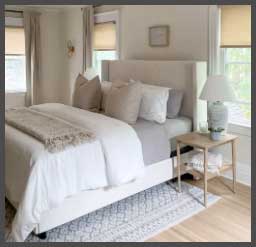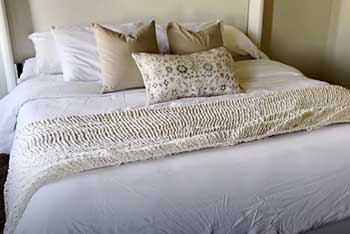The bed. It’s one of the most important pieces of furniture in your home, yet often overlooked. After all, you spend about a third of your life sleeping, so why not invest in a quality bed?
When it comes to top bed brands, Hanson and Tilly consistently rise to the top. Both offer high-end beds known for their craftsmanship, comfort and style.
But which is better?
Let’s dive into the key differences between Hanson and Tilly to help you decide.
A Brief Comparison Table
| Feature | Hanson | Tilly |
| Construction | Traditional joinery like mortise and tenon | Monocoque platform carved from single wood piece |
| Customization | Some flexibility for custom sizing | Fully bespoke, handmade to order |
| Size Options | Mainly standard sizes like Queen, King | Any size accommodated |
| Lead Times | Ready-to-ship options available | 4-8 weeks typically |
| Mattress Materials | Latex, wool, organic cotton | Lambswool, horsetail, cotton |
| Mattress Feel | Uniformly supportive | Zoned contouring |
| Aesthetic | Streamlined and contemporary | Classic warmth and delicacy |
| Price Range | $2,500-$4,000 for Queen | $4,500+ for Queen |
Overview of Hanson Beds

Founded in 2003, Hanson is a US-based company specializing in handcrafted beds and mattresses.
Their focus is on using natural, sustainable materials to create supportive and comfortable sleep systems.
Hanson beds feature all-wood construction, with options like solid walnut, maple and cherry.
Beds are available in sleek platform styles as well as storage beds with drawers built into the base.
The company uses materials like natural latex, wool and organic cotton for their mattresses. The result is a breathable and resilient sleep surface that contours to your body.
When it comes to craftsmanship, Hanson takes great pride in their work. Beds are handmade in their Los Angeles workshop by skilled artisans. With an eye for detail, each bed is carefully constructed and finished for heirloom-quality.
Key Features:
- Handcrafted in the USA from solid wood
- Natural, eco-friendly materials
- Latex, wool and organic cotton mattresses
- Platform and storage bed options
- Heirloom-quality with artisanal construction
Overview of Tilly Beds
British brand Tilly creates bespoke beds and mattresses blending traditional craft with modern sensibilities.
Tilly beds feature elegantly curved headboards and footboards, made from sustainably-sourced European hardwoods. Smooth sloping lines and subtle detailing gives Tilly beds a warm, welcoming aesthetic.
For the mattress, Tilly uses premium natural materials like cotton, lambswool and horsetail. Hand-tufting and intricate side-stitching creates a supportive sleep surface that contours to your body.
Based in London, Tilly still handmakes every bed frame in their England workshop. Skilled craftspeople shape the wood,joinery and finish each frame with care. It’s this meticulous handcrafting that makes Tilly beds so special.
Key Features:
- Handcrafted in England from hardwood
- Elegant curves and subtle details
- Natural fill mattresses with cotton, lambswool, etc
- Supportive hand-tufted and side-stitched surface
- Sustainably sourced materials
Key Differences Between Hanson And Tilly Beds
Comparing Bed Construction
One of the biggest differences between Hanson and Tilly is the style of wood construction.
- Hanson uses joinery like mortise and tenon to interlock solid wood pieces into a sturdy frame. This type of simple but strong joinery is traditional for bedmaking.
- Tilly, on the other hand, shapes the entire bed frame from a single piece of wood. This monocoque construction gives Tilly beds their fluid, curving forms. It’s a more modern approach requiring advanced woodworking skills.
Both methods have their merits. Traditional joinery allows more flexibility and options for Hanson beds. Tilly’s seamless platform frames have an elegant simplicity. It comes down to your personal style preference.
Customization and Size Options
When ordering a bed, customization and size availability are important factors.
- Hanson offers more standard sizing, with popular options like Queen, King and California King. They have some flexibility for custom dimensions, but not to the extent of Tilly’s bespoke beds.
- Tilly beds are made to order based on your exact specifications. Their artisans can accommodate any mattress size and shape. This total customization comes at a price – longer lead times and higher costs.
Hanson has a more accessible ready-to-ship selection. Tilly needs ample lead time but gives you more freedom to design your ideal bed.
Comparing Mattresses
Let’s move from the bed frame to the mattress – the comfort layer where you’ll spend all night.
Both Hanson and Tilly focus on natural, breathable materials in their mattresses. However, there are some composition differences:

- Hanson uses latex, wool and organic cotton. Latex provides conforming support and resilience.
- Tilly contains materials like lambswool, horsetail and cotton. The horsetail adds breathability while lambswool gently cradles pressure points.
- Hanson mattresses have more of a uniform solid feel. Tilly mattresses are softer, with more zoning for contouring.
- Hanson’s simple materials and solid feel suits more sleep positions. Tilly better accommodates side sleepers needing pressure relief.
When it comes to quality, both mattresses are exquisitely made by hand with premium materials. It comes down to your sleep style preference.
Aesthetic Styling
Beyond construction, the visual styling of these beds differs quite a bit.
- Hanson beds have a streamlined, contemporary look. Their solid wood platform beds come in muted neutrals that feel relaxed and understated. Clean lines and minimal adornment give a simple, Scandinavian-inspired vibe.
- Tilly’s ornately curved headboards and footboards have a more romantic classic feel. The sweeping shapes and delicate details create a sense of warmth and welcome. Tilly beds lean traditional but with some modern flaire.
Both brands reflect skilled artisanal craft – just with different design perspectives. It comes down to which aesthetic speaks to your style sensibilities.
Evaluating Price and Value
When comparing high-end brands, price inevitably comes into play. In general, both Hanson and Tilly sit at the top end of the market for premium beds. However, Tilly beds come at a notably higher cost.
A Queen size Hanson bed generally ranges $2,500-$4,000 for the frame and mattress together.
Tilly’s Queen combinations start around $4,500 and can go up significantly for custom sizes. Their bespoke production and hand crafting does come at a price.
For many customers, Tilly’s beds represent a worthwhile long-term investment in quality rest. The exquisite craftsmanship and custom options give a bed with heirloom-level value.
However, Hanson also crafts an excellent bed at a more accessible luxury price point. Their offerings deliver lasting comfort and support with natural materials.
Ultimately, assessing your budget and priorities will determine if the additional costs are justified.
Pros and Cons Summary
To recap the key points, here’s a breakdown of the main pros and cons for each brand:
Hanson
Pros
- Quality joinery construction
- More standard sizing options
- Streamlined Scandinavian styling
- Natural materials at lower luxury price point
Cons
- Less customization flexibility
- Not as breathable as Tilly mattress
- More classic traditional look
Tilly
Pros
- Bespoke beds with total customization
- Seamless curving monocoque construction
- Elegant warmth and delicacy in design
- Very breathable, contouring mattress
Cons
- Notably higher prices for custom work
- Longer lead times for production
- Traditional shapes less modern
Which Is Best For You?
At the end of the day, deciding between Hanson vs Tilly comes down to your priorities:
- If you value customization and unique style, Tilly is hard to beat. Their beds feel like a work of art.
- If you want quality materials at a friendlier price point, Hanson delivers exceptional comfort and support.
- Seek a balance of comfort, support and breathability in the mattress materials and construction.
- Consider your room size and aesthetic – both brands offer different stylistic perspectives.
Take time to review sizing, options, and pricing to make sure your investment pays off in restful nights for years to come. Understanding these key contrasts helps narrow down which brand truly suits your needs.
Frequently Asked Questions (FAQ)
There is no universally “best” bed style, as personal needs and preferences vary. Platform and storage beds are popular modern options. Four poster beds provide a traditional, ornate style. For small spaces, beds with built-in headboards optimize footprint. Testing different mattress materials and speaking with sleep experts can help determine the ideal bed for quality rest.
Currently, platform beds are widely popular for their simplicity and minimalist aesthetics. Upholstered beds also gain favor for their soft, inviting look and texture. Canopy beds and murphy beds help maximize smaller spaces. Ultimately trends come and go – focus on choosing what provides the most comfortable and useable bed for your needs.
Platform beds without footboards represent one of the most popular bed designs currently. Their simple solid or slatted platform base works well with many modern mattress types, while taking up minimal floor space. Platform beds come in many materials like wood, metal and upholstery to fit design tastes. Adjustable bases are also growing in popularity for their customizable comfort.
Current bed trends favor slim, minimalist designs well suited to small spaces. Simple platform beds are very in style, often with integrated headboards and neutral, muted colors. Canopy beds also gain interest for their sense of coziness and touch of drama.
For materials, mixed textures like wood, metal and fabric come into fashion, blending natural and sleek. In general, versatility and minimalism drive contemporary bed trends. Classic styles still hold interest for their sense of permanence and quality.
Final Thoughts
In comparing Hanson and Tilly beds, the main differences come down to construction, customization, price, and aesthetic style.
Hanson offers traditionally-crafted beds with some customization flexibility and a streamlined, contemporary style at a lower luxury price point.
Tilly provides fully bespoke, hand-carved beds with elegantly classic details and superior contouring mattresses, but at a notably higher cost.
Ultimately, Tilly is ideal for those desiring a custom-tailored bed as a unique work of art. Hanson appeals to those wanting natural materials and quality craftsmanship at a more accessible premium price.
Carefully weighing priorities like budget, design tastes, and sleep needs will determine which brand truly suits an individual’s ideal bed.
